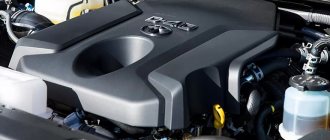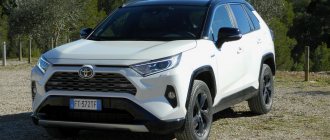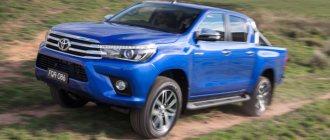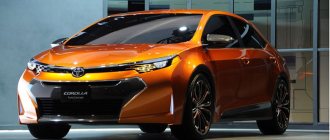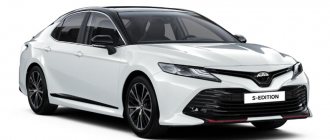Toyota RAV4 Test Park: Difficult choice
Formulating an ideology is a difficult task. And not only on a national scale, but also in private everyday situations - such as choosing a car. Gasoline or diesel? Based on the results of a long test of both versions of the Toyota RAV4, you can collect information for reflection - the decision for everyone will remain personal... 2231 cm3, diesel automatic transmission, 6 speeds, all-wheel drive RUB 1,562,000. Competitors
Honda CR-V Petrol, 2.0, 150 hp, AT-5 RUB 1,379,000
Kia Sportage Diz., 2.0, 136 hp, AT-6 RUB 1,399,900 Volkswagen Tiguan Diz., 2.0, 140 hp, AT-6 RUB 1,492,220 The Toyota RAV4 crossover with a 2.2-liter diesel engine replaced a 2.5-liter gasoline modification in the test park in mid-December - real winter cold had just arrived in Moscow. Very useful: “folk” beliefs regarding the problems of operating diesel engines in cold weather are still strong. It's time to dispel them! The cars are equipped almost identically: 6-speed hydromechanical automatic transmission, all-wheel drive, and a wide range of options. The only difference is that the white diesel Rafik in the Prestige configuration differs from the gray petrol Rafik in the Prestige Plus configuration in the absence of roof rails. Warm welcome
The fact that there is a definite minus behind the wheel is immediately noticeable behind the wheel of a diesel RAV4: the unheated engine at idle rumbles quite like a tractor.
However, upon reaching operating temperature, his voice becomes noticeably softer. But the engine does not warm up for long, and thanks to the standard reheater, the climate control system begins to blow warm air soon after the start. The January frosts, when the temperature in the Moscow region tended to -30°, did not bring any particular difficulties - after an overnight stay, the diesel RAV4, filled with winter fuel from large network gas stations, started up regularly: it would take a pause of a few seconds after pressing the start button to warm up the spark plugs incandescent, and from the first scroll it will purr vigorously. Is it that the transmission at such moments reminds you at first that it is well beyond -20° outside the window. In normal life, it works smoothly and delicately, but here the gears change rather roughly. Another feature of winter life is the high consumption of anti-freeze. And all because of the xenon low beam with a headlight washer, which does not spare liquid. On another slushy day after a snowfall, when city services pour a lethal dose of reagents onto the streets, a full tank can be filled in just a day of active travel. Kindred spirits
The petrol 180-horsepower “four” was remembered for its flexible character: it drives powerfully, but not at all harshly.
The diesel RAV4 “according to the passport” is weaker (150 hp) and loses somewhat in dynamics - with acceleration to “hundreds” in 10 s (versus 9.4 s). In practice, this difference is not felt much: the engine’s thrust is quite enough for both vigorous acceleration and safe overtaking. The transmission of the RAV4 with a diesel engine has a full manual mode - you can change gears using the paddles on the steering wheel or by moving the selector. On a gasoline crossover, there are no paddles on the steering wheel, and in S mode, by nodding the lever you can only limit the gearbox's shift range. Petrol and diesel RAV4 in the maximum configuration cost almost the same - 1,568,000 rubles. and 1,562,000 rub. accordingly, and the more difficult it is to make a choice! I prefer a diesel engine - in terms of dynamics it is practically no worse than a gasoline engine, it also does not cause any special problems with warming up the interior, but at the same time it significantly saves fuel. If a gasoline “Rafik” in similar conditions (significant highway runs and daily hustle and bustle in Moscow traffic jams) consumed about 10.6 liters of “ninety-five” per 100 km, then a diesel engine in winter fits into 8.6 liters of diesel fuel per “hundred”! Otherwise, the cars are practically the same: the two-mode heating of the leather seats works equally effectively, the finishing is similarly high-quality, but not at all luxurious, and the navigation still understands Russian speech tolerably well. After pressing the voice control button on the right spoke of the steering wheel, the desired street (or some other useful function) should be called loudly and clearly - and the desired menu item will most likely be found and displayed on the central display. And the machine reacts to unintelligible or “unauthorized” remarks with a warning “What did you say?” Commendable delicacy! Interior – 8.0.
Selectivity The crossover is equipped with leather seats, starting with the “penultimate” configuration “Elegance+”, but only the driver’s seat has electrical adjustments, as well as an automatic window mode – only at the driver’s door.
In general, the interior is well made, but not luxurious. Passengers – 8.5.
For everyone, the rear sofa is conveniently adjustable - the back sections can be tilted to different angles, including reclining here.
There is also a wide armrest. The seat belt indicator monitors the situation in the back row as well. Requests
1. The RAV4 diesel transmission can be controlled manually - both by the steering wheel paddles and the selector.
2. The multimedia system has a voice control function - say the address loudly and clearly! 3. Readings from the large speedometer scale are read “on the fly” - everything is simple and concise. Small mechanization
Using the electric trunk button, you can not only close the door, but also adjust the height of its lift.
With brilliance
The RAV4 comes in just 13 trim levels.
But for metallic or pearlescent paint you will have to pay extra - 13,000 rubles. or 19,500 rub. Reporting period 2 months Test mileage 6617 km Fuel consumed (DF) 566 l Average consumption 8.6 l/100 km Cost of refueling 18,680 rubles. I like
the dynamics with low fuel consumption of the diesel version, versatility.
I don’t like
Leather chairs are good, but I wouldn’t want obvious savings on small things in equipment and finishing.
Toyota RAV4 Retail price RUB 1,562,000
Prestige
versions However, cars are now available for order in the top version “Prestige+” - with them. The cost of such a RAV4 with a gasoline engine is RUB 1,568,000, and a diesel engine is RUB 1,562,000. Overall rating: 8.0.
The gasoline crossover is a little more dynamic, but the diesel consumes less fuel, and in winter in the conditions of central Russia it does not cause much trouble. Considering that the prices for RAV4 with gasoline and diesel engines in similar trim levels are close, the choice for a potential buyer of a Japanese crossover will not be easy.
07.04.2016
Weaknesses of the Toyota 2.2 D-4D (2AD-FTV) turbodiesel
Turbodiesels of the AD family appeared on Toyota cars in 2005 and were produced until 2015. The 2.2-liter engine appeared first, then production of the 2-liter engine began. Both power units are built on a block with a cylinder diameter of 86 mm and differ in piston stroke. The 2.2-liter version received balancer shafts, which are driven from the crankshaft by a gear transmission.
The AD diesel block is aluminum, with an open cooling jacket. At the casting stage, thin-walled cast iron sleeves are placed into the block. That is, its design corresponds to the times: the block is as lightweight as possible and, as conceived by Japanese engineers, cannot be bored.
The 2-liter 1AD-FTV engine develops 124-126 hp, while the 2.2-liter 2AD-FTV produces between 136 and 150 hp. There is also a 177 hp version of the 2AD-FHV with dual D-CAT catalyst.
These engines were available for all mid-size European Toyota models such as Auris, Corolla, Avensis and RAV4. The 2.2-liter engine was also installed on the Lexus IS.
Watch on our YouTube channel the disassembly of the 2.2 D-4D (2AD-FTV) engine removed from a 2006 Toyota Avensis.
You can choose and buy a Toyota gasoline or diesel engine in our catalog of contract engines.
Crankshaft sensor
A common failure of the D-4D diesel engine is the failure of the crankshaft position sensor. Due to its malfunction, the engine may jerk once when accelerating. And after a while it may simply stall and not start again. When cranking the starter, the tachometer needle will not rise, indicating the crankshaft sensor.
Turbine
Diesels of the AD family received variable geometry turbines from IHI. Model VB, with indexes from 13 to 17. The geometry servo drive in all versions is vacuum. On the forced version 2AD-FHV (177 hp), the turbine is liquid cooled.
A standard problem associated with jamming of geometry blades is engine twitching during acceleration. Also, these symptoms are accompanied by errors indicating that the turbine is under- or over-inflated. To fix this problem, you need to remove the turbine, disassemble its hot volute and clean it from soot and carbon deposits.
Since the actuator on the turbine is vacuum, it is controlled by an electric vacuum valve. It happens that this valve becomes clogged or simply fails. In this case, the check engine light comes on at high speed and disappears after the engine is restarted. The vacuum valve on the D-4D engine can be cleaned.
You can select and buy a turbine for the Toyota 2.2 D-4D diesel engine in our catalog of contract spare parts.
EGR valve
The EGR valve on all AD diesel variants is equipped with feedback. The EGR valve has to be cleaned every 30,000 km or even more often. Typically, a stuck valve makes itself known when the engine is warm: traction is lost, and the car practically does not accelerate at highway speeds.
You can select and buy an EGR valve for the Toyota 2.2 D-4D diesel engine in our catalog of contract spare parts.
injection pump
The Denso HP3 double-piston injection pump is installed on the rear side of the cylinder head and is driven by the exhaust camshaft. The maximum fuel injection pressure, depending on the power of the AD diesel engine, ranges from 1,670 to 2,000 bar. On the 2AD-FTV engine in question, the pump “presses” a maximum of 1,800 bar. The injection pump is quite durable and reliable, but it can be instantly killed by dirty diesel fuel from a canister.
The SCV valve literally controls the amount of fuel drawn into the injection pump. The pressure in the entire fuel system depends on it. Also responsible for high fuel pressure is a valve on the fuel rail, which releases excess pressure in normal or emergency mode. On the forced version 2AD-FHV this valve is electronically controlled, on all others it is mechanical.
If the SCV valve malfunctions, the required fuel pressure is not created in the fuel system, or the pressure fluctuates, causing the speed to fluctuate. Also, when cold, this valve may cause the engine to stall after a couple of unsuccessful starts. The valve needs to be replaced with a new one.
You can select and buy a fuel injection pump for the Toyota 2.2 D-4D diesel engine in our catalog of contract spare parts.
Injectors
The basic version of injectors on AD diesel engines are electromagnetic injectors, found on these engines with power up to 150 hp. until 2010. But the most powerful version of the 2AD-FHV uses piezo injectors. Later, all versions of these engines that comply with Euro 5 were equipped with piezo injectors. On diesel engines of this family with a particulate filter, in addition to 4 injectors for injecting fuel into the cylinders, there is also a 5th injector that injects fuel into the exhaust. It is installed in the exhaust channel of the 4th cylinder. This injector is turned off when the particulate filter is cut and sewn.
The injectors run for about 250,000 km. When they wear out, they begin to drain fuel into the return line, which is also indicated by the corresponding error (P0093). Also, wear of the injectors (one or more) is indicated by the spread of injection correction across the cylinders. In this case, the engine, especially when hot, does not start on the first try. There may also be vibrations at idle or when accelerating in some rpm range.
New electromagnetic injectors cost about $230, they can also be repaired, but piezoelectric injectors have to be replaced entirely. One new piezo injector for a D-4D engine costs about $500-$700.
But in fairness, we note that solutions are emerging for the restoration of piezo injectors: you can get new nozzles and diaphragm valves for them. They also offer repairs of such injectors from used elements.
When installing a used piezo injector, you need to write the code printed on it in order to reset the adaptations of the old worn out injector.
It is worth noting that you cannot skimp on fuel filters. There have been cases when injectors on 2.2 D-4D engines became clogged with fluff from low-quality filters.
Also, if there are problems with the fuel system, when all components have been checked, do not forget about the wiring. Rarely, the wires laid in protective casings from the injectors to the control unit can fray and break. In this case, the engine stalls immediately after starting: the fuel injection pump creates the required pressure, but due to broken wires there is no connection with the injectors after starting.
The injectors become sour if the washers underneath them burn out. It is highly advisable to change washers every 60,000 km. When disassembled for removal with an extractor, piezo injectors are simply “liquidated” - they will no longer work. If the washers burn out, the nuts near the injector nozzles may also burn out. As a result, the injector assembly will have to be replaced!
Rubber seals (rings) on the injector rods prevent moisture from entering the cylinders.
You can select and buy injectors for the Toyota 2.2 D-4D diesel engine in our catalog of contract spare parts.
Valve train chain
The cast cover (casing) of the gas distribution mechanism contains a pump and an oil pump. The pump is driven by a belt of mounted units. And the oil pump is driven directly from the crankshaft.
The timing chain is single-row, tensioned by a hydraulic tensioner with a stopper. The chain is sprayed with oil using an oil nozzle. We have not encountered any complaints about timing chain stretching on this engine.
Cylinder head and its gasket
The aluminum head has two camshafts. The timing chain drives the exhaust shaft, and the intake shaft is driven from it by a gear drive. Hydraulic compensators are used to drive the valves.
A well-known widespread problem with AD family diesel engines due to manufacturing defects is cylinder head gasket failure. Because of this, antifreeze can get into the cylinders or gases from the cylinders make their way into the cooling system. Gases “inflate” the pipes of the cooling system, “bubble” in the expansion tank, and expel antifreeze from it. Also, darkening of the antifreeze or the appearance of soot deposits on the tank lid is noticeable.
The cylinder head gasket was defective on AD engines in the first years of production, until 2009, and was replaced under warranty. But the problem of burning out the cylinder head gasket still occurs on new Toyota AD diesel engines, even with mileages of up to 100,000 km.
Also, if the gasket breaks down, erosion of the cylinder block or even the appearance of microcracks is possible.
You can select and buy a cylinder head (cylinder head) for the Toyota 2.2 D-4D diesel engine in our catalog of contract spare parts.
Zhor oil
Toyota engineers miscalculated the pistons and piston rings of the AD family of diesel engines. Since new, these engines have been characterized by high oil consumption due to waste. This entailed a number of troubles: due to the large volume of oil deposits, the valves of the EGR system quickly became clogged, deposits appeared on the pistons, and damage to the cylinder head gasket occurred. The oil burn was recognized as a factory defect. Under warranty, the pistons, their rings and all crankshaft liners were replaced on these engines.
Pistons
The pistons are made of aluminum alloy, but the groove of the upper compression ring is filled with a ni-resist insert. Niresist is a heat-resistant nickel cast iron, thanks to which the groove of the upper ring has an increased service life, and the piston itself expands less when heated.
Crankshaft
The crankshaft rests on a cast aluminum crankcase, which contains cast iron main journal caps.
Here, using the links, you can see the availability of specific Toyota Auris, Toyota Corolla, Toyota Corolla Verso, Toyota Avensis and Toyota RAV4 and other models at the disassembly site and order auto parts from them.
Farewell lines about Toyota diesel (((
A year has passed since the engine was rebuilt under warranty. The other day, after a long car trip (more than 2000 km), I decided, out of habit, to check the oil level and all fluids under the hood. Having opened the hood, I saw a familiar picture from last year, namely the level of antifreeze in the expansion barrel was about 3 cm, and everything under the soot space near the expansion barrel was splashed with dried antifreeze. The next day I was already at the official dealer for diagnostics (the car was still under warranty), after two hours of diagnostics the verdict: repair and replacement of the engine cylinder block, the total mileage at that time was 76 thousand km.. For the entire period of operation by me ( driving for more than 25 years) of various brands of cars (from Lada to Mercedes) with different mileage and condition (from new to cars with a mileage of more than 100 thousand km) never, in any of the cars, an engine overhaul was required, for 2.5 years of operation Toyotas - 2 times!!! In general, on the same day, without hesitation, I handed over the car via “trade-in” to the official dealer. If you take away the emotions, then a brief impression of the car is as follows: — interior: everything is quite comfortable and practical, the sound insulation has become better, but not so good, during operation the left edge of the driver’s seat began to rub and crack (leather interior); — interior: never got used to it; - body: immediately after purchase the front end was covered with a protective film, it protects from sand and small stones flying from under the cars in front, slightly larger stones pierce the film along with the paint to the primer, over the entire period of time there were about five such “breakthroughs” on the front part of the hood , I can say for sure that I will not make a protective film for my next car. The rest of the body is as usual; in my opinion, the car was painted with a very thin layer of paint. — transmission and automatic transmission: I didn’t have any complaints, everything is fine. — suspension: very stiff, good for the city, but outside the city where the roads are worse, any joint or pothole is transferred to the “fifth point” and again, at the last maintenance, under warranty, something was changed in the suspension (I don’t remember now) , before this (maybe I was lucky) this didn’t happen on all the new cars I had before Toyota; — the car has a lot of electronics, for 2.5 years of daily use and Moscow reagents on the road in winter, there were no problems; — engine: when compared with the gasoline version, in my opinion, diesel is very good in terms of acceleration and efficiency, consumption according to the computer for the entire period of operation was 7.5 liters per 100 km, which corresponds to reality, there were no problems with starting in winter, no additives which ones did not pour. Reliability - no comment. Good luck to everyone on the roads!




